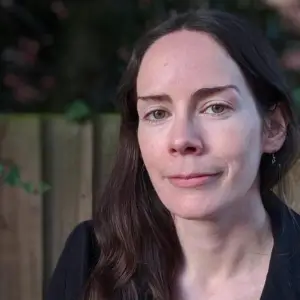Stories don’t happen in a void. They take place somewhere. Whether it’s a quiet village cafe or a distant star system, landscape and location bring a story to life. As writers, we know these locations aren’t chosen randomly. Location can have a huge impact on your fiction. It connects characters, illustrates an idea, captures a moment in time, reveals secrets, and engages your audience in the narrative you are crafting.
Create the right landscape, and you can tell your story in a way that feels fresh and intriguing.
On the blog today, we welcome Catriona Silvey, acclaimed author of the Sunday Times bestseller Meet Me in Another Life (2021), currently in development as a feature film, and the time-travel romance Love and Other Paradoxes (2025). In this article, Catriona shines a light on how to use landscape and location to really bring your story to life, writing a world in which your reader can truly lose themselves.

In fiction as in life, events play out in the context of a specific place or places. And just as our lives are shaped by where we live and work, the setting of a story – be it real or imaginary – shapes the lives of our characters. Location isn’t just a backdrop, it’s a living, breathing presence.
Here are five tips for breathing extra life into your story by fully exploring its landscape.
1. Do your research
You may think this only applies if you’re setting your novel in a real place. But even if you’re creating a fantastical city or an alien planet, your setting will feel more convincing if you take inspiration from real environments.
Research doesn’t have to mean actually visiting a place (although if you can, it helps!). It could mean asking friends who have lived or grown up in that landscape to share their experiences. It could mean using the vast resources of the internet to tap the expertise of a community subreddit, or to trace the paths your characters might walk. The more sources you can gather your information from, the better: the same place can be infinite places, depending on who’s looking at it.
.webp)
Research matters even if you’re writing a place you already know well. My book Love and Other Paradoxes is set in Cambridge during a time when I lived there myself, in the early 2000s, but there were still details I couldn’t rely on my memory for while writing, and I had to consult old photographs and street maps to make sure the location was authentic for that era of modern history. Was the Laser Quest still open in 2005, for example? What did the now-demolished street that led there look like?
{{blog-banner-24="/blog-banners"}}
2. Use your imagination
Research is a double-edged sword. When used well, it can lend your setting specificity and depth. But when overused, it can bog down your narrative in extraneous detail; applied too rigidly, it can prevent you from finding solutions to your story’s problems.
Remember: you’re writing a novel, not a travel guide. Even if you’ve exhaustively researched every detail of your setting, not all those details have to make it onto the page. A few striking, specific notes that appeal to the reader’s senses are enough. And don’t be afraid to embroider on what you discovered. If the perfect venue for a scene doesn’t exist, then invent it, and use what you’ve learned to weave it seamlessly in with reality.
.webp)
The exact balance to strike between research and imagination will depend on the kind of novel you are writing. For a gritty thriller set in a specific city, authentic grounding in a real place might be important to the reader’s investment. For a more speculative work, the constraints might be looser.
My own research helped me to ground the early chapters of Meet Me in Another Life in the novel’s setting of Cologne, but as the book moved on and things started to get weird, the details I included were sometimes deliberately wrong or contradictory, adding to the surreal feeling of a world coming undone.
.webp)
3. Setting is inextricable from character
There’s no such place as Cambridge. In reality, it’s many places: the version of the city experienced by an undergraduate student is vastly different from the version experienced by a pensioner living in the suburbs. This is true both physically – many places that are regular haunts for one demographic are inaccessible by the other – and emotionally.
A place in the abstract is just a collection of stuff. Setting comes alive when we see it from the perspective of a specific character. Decide how your character feels about the place they’re in – fond, over-familiar, dazzled, frustrated, terrified – and how that might rhyme or contrast with other characters’ perspectives.
.webp)
In Love and Other Paradoxes, Joe and Esi’s clashing attitudes to Cambridge form a running backdrop to their deeper disagreements. For Joe, Cambridge is by turns alienating and comforting, offering a refuge against the onrushing threat of the real world while frequently reminding him he doesn’t belong. For Esi, it’s a hostile and unfamiliar landscape, full of baffling rules and threatening authorities; it’s also the place she blames for taking her mother away from her. As their attitudes to themselves and each other change across the course of the novel, so do their attitudes to Cambridge and their place within it.
4. Landscapes are dynamic
The word ‘setting’ implies that the place where a story happens is static, an unchanging backdrop to the action. But these places have the same potential for growth, change, and downfall as characters themselves.
This is most obvious in stories where the landscape in which the narrative takes place is being threatened: a city under attack, or a habitat at risk of destruction, for example. But you can also show it in smaller ways: how changes in weather or climate transform the feel of a city, how the physical environment reflects a rise or fall in a nation’s fortunes.
.webp)
Change can happen not just in the place itself, but in how it appears through the lens of the characters’ feelings about it. In the later stages of Meet Me in Another Life, Thora and Santi come to realise they are trapped in the strange loop they are experiencing, and hence trapped in Cologne. Their differing responses – Thora turning against the city in her desperate attempts to escape, Santi embracing it in an effort to discover the meaning behind their situation – both illustrate their characters and become the driver of further action.
.webp)
5. Have fun while you’re telling the story!
There are so many ways to use the landscape of your world to bring your novel to life. It can subtly illustrate the themes of your story through the details you choose to highlight. The locations you use can drive plot, putting your characters in places that challenge them or bring out the best in them.
But don’t get so caught up in making a particular landscape work for your novel that you forget to have fun with it!
Many of my favourite scenes to write have relied heavily on setting: the narrow, tourist-crowded streets of Cambridge city centre, where Joe flees from Esi and finally escapes by jumping onto a punt; an abandoned house on the outskirts of Cologne, where Santi paints images from his and Thora’s many lives all over the walls.
Location isn’t just a backdrop, it’s a living, breathing presence.
—Catriona Silvey
There’s a joy, too, in creating touchstone places that will become as familiar to your readers as to your characters: Der Zentaur, the bar where Thora and Santi meet again and again; the café on Mill Road where Esi and Joe clash and come together over time travel and true love.
The fun of reading is that it allows us to meet people who never existed, experience things we’ve never done, and go to places we’ve never been – maybe even places that aren’t real. Remember that your book is a door. Write landscapes your readers will want to live in, or at least visit for a while.
.webp)
Love and Other Paradoxes by Catriona Silvey
Cambridge University, 2005: Student Joe Greene scribbles verses in the margins of his notebook, dreaming of a future where his words will echo through the ages, all while doubting it could ever happen.
Then, the future quite literally finds him—in the form of Esi. She’s part of a time-traveling tour, a trip for people in the future to witness history’s greatest moments firsthand. The star of this tour? Joe Greene. In Esi’s era, Joe is as renowned as Shakespeare. And he’s about to meet Diana, a fellow student and aspiring actress, who will become his muse and the subject of his famous love poems.
But Esi is harboring a secret. She’s not here because she idolizes Joe—actually, she thinks his poetry is overrated. Something will happen at Cambridge this year that will wreck Esi’s life, and she’s hell-bent on changing it.
When Esi goes rogue from her tour, she bumps into Joe and sends his destiny into a tailspin. To save both their futures, Esi becomes Joe’s dating coach, helping him win over Diana. But when Joe’s romantic endeavors go off-script—and worse, he starts falling for Esi instead—they both face a crucial question.
Is the future set in stone, or can we pen our own fates?
.webp)
Members of The Novelry can enjoy a live writing class with Catriona Silvey in the Catch Up TV library now. Find out more about Catriona at her website, and be sure to order Love and Other Paradoxes now in the U.K. and in the U.S.!
.webp)


.avif)

.webp)
.webp)